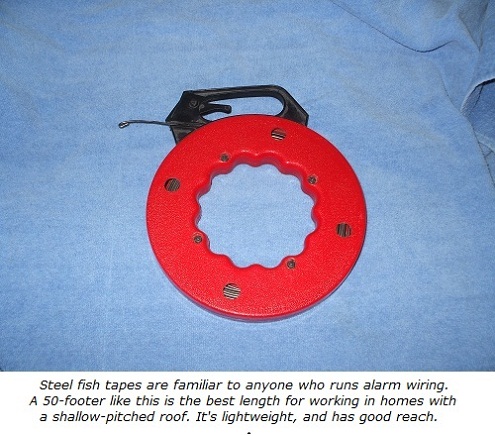- Home
- Compare Systems
- Cheap Systems
- Free Quotes
- DIY Systems
- Hardwired Systems
- Wireless Systems
- Smoke Detectors
- Medical Alarms
- Alarm Monitoring
- Cameras & Video
- Ademco
- ADT Security
- Brinks Security
- Broadview
- DSC Security
- FBI Alarms
- GE Security
- Honeywell
- Link Interactive
- Monitronics
- Moose
- Napco
- Protection 1
- Radionics
- Simplisafe
- Alarm Manuals
- Alarm System Parts
- Alarm Tools
- Troubleshooting
- FAQ
- Glossary
- Sitemap
- About Me
- Contact Me
Choosing Fish Tapes for Home Alarm Wiring
Fish tapes are some of the most commonly used tools for running home
alarm wiring in existing construction. Without a good tape, and the
skill to use it, most hardwired alarm installations would require lots
of drywall repair.
If you’re installing a do it yourself home alarm, or if you work in the
alarm business as a security technician, you’ll need to be familiar with
how to use and take care of this tool.
Tapes are available at most home improvement centers, as well as online. See 50-foot fish tape at Amazon.com.
In use, the end of the tape is sent up into the attic through a hole drilled at the alarm device location. Then, a wire is tied onto the end and pulled back down. The alarm equipment can then be connected to the wire and mounted.
Hardwired home security systems require a physical electrical connection
to each alarm device. Home security devices can include door and window
switches, motion and glassbreak sensors, keypads, sirens, smoke
detectors, and more.
Besides the fish tape, there are other tools available for fishing wires. I've also used glow rods, and long drill bits
which can be sent up shaft-first. These work fine when there is plenty
of attic clearance above them, like in the middle area of a typical
ranch-style home. This is where keypads, sirens, and motion detectors
are often located.
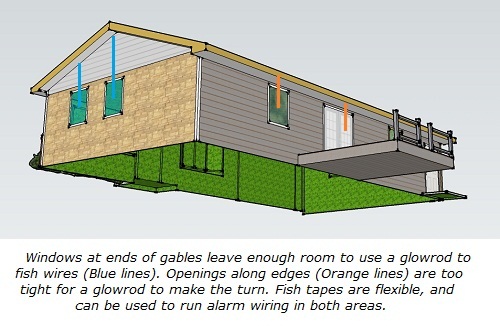
Toward the outside walls though, the slope of the roof pitches
downward. In many attic spaces, there are only a few inches between the
top of the wall and the roofline. Once a glow rod or drill bit hits the
plywood sheeting of the roof, it can go no further.
This means that whoever is in the attic must crawl out to the very edge
of the house to attach a wire. With the slope of the roof, this is the
tightest area in an attic. Getting to these spots can be difficult or
impossible due to duct work, plumbing pipes, and other obstacles. Even
when you can reach the outer areas, you’ll be crawling face-first through itchy, dusty attic insulation.
Using a fish tape, plus some skill and luck, you can save a lot of time, effort, and discomfort.
Choosing Which Tape to Use
Fish tapes come in many sizes, often in 25 foot increments. I’ve
found the 50-foot length to be best for fishing alarm wiring, as it
allows you to easily spin and steer the tape as you send it into the
attic.
Larger tapes are heavy, hard to control, and unnecessarily long. Save
the longer fish tapes for pulling extended wire runs through conduit.
Shorter tapes leave you no margin for error. The next-shortest standard
length below 50 feet is 25-feet. If the fish tape ever becomes
irretrievably jammed (and eventually it will!), you’ll have to cut it
off. This would then leave a 25-foot tape too short to use effectively.
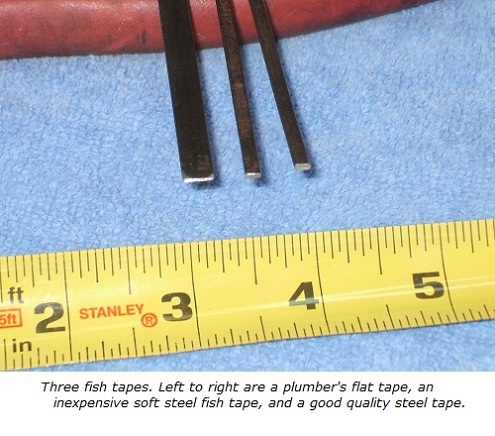
Check the shape of the steel blade. Some inexpensive tapes are made
from soft, flat steel. These tend to be too flimsy to push through
insulation, and don’t spring back to their original shape very well.
Better quality tapes tend to be almost oval in cross-section. These are
made from “springier” steel, and will bounce back after being bent.
So, look for a 50-foot tape with a high-quality steel blade, 1/8-inch
wide. This size will easily fit through the 3/8-inch holes commonly
drilled for alarm wiring, even after a hook is bent in the end of it.
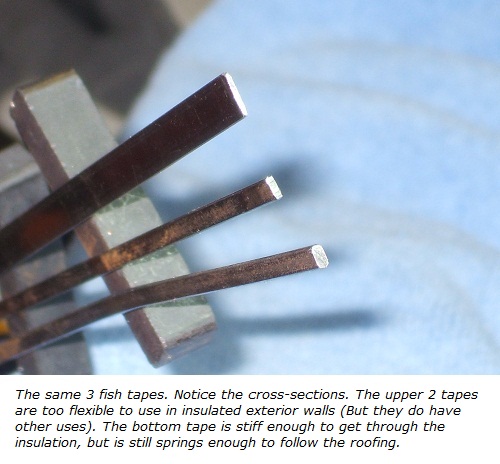
Using Fish Tapes
Installing alarm wiring is best done with two people, who I’ll refer
to as the “ground guy” and the “attic rat”. If you’re only pulling a
wire or two, you can do both parts by yourself. Climbing into and out of
the attic over and over, along with crawling to find the fish tape each
time, is very tiring.
Doing all the runs yourself, you’d probably be exhausted after 4-5
pulls, unless you’re an Ironman competitor. So, what’s the solution?
Getting a friend or co-worker to help you is usually the best way to go.
Universally accepted currency for this assistance may include pizza,
beer and other beverages, and of course, good old cash. You may also be able to trade for your help on one of his projects.
Choose your help wisely. An “attic rat” with a slow, clumsy “ground guy” will be in for a very long day. And of course, if it’s your house you’re working on, you’ll be the one in the attic.
So, what’s involved? Basically, three things have to happen:
- The end of the tape must be snaked through each of the holes drilled up into the attic
- A wire must be attached to the eye and pulled down at each device
- The other ends of all the wires must be cut from their spools or boxes and be pulled down at the alarm panel location
The first part, fishing the tape into the attic, is done by the ground guy.
The second chore is left to the attic rat. He/she has the dubious honor
of crawling through insulation, finding the end of the blade, and tying
wires to it.
If you’ve cleverly located the alarm panel next to an attic access
point, or scuttle hole, you’re nearly done with the third step! Just
gather up all the loose ends, wrap them into a bundle with electrical
tape, and fish it down and out of the hole where the main panel will be
mounted.
Bending a New Hook in a Fish Tape
The factory-formed eye or hook that comes with new fish tapes may
last awhile, but it will eventually break. You’ll have to bend a new
hook in the end in order to attach wires easily.
The easiest way I’ve found to do this is using a pair of wire strippers
having a wire-bending hole. The popular T-Strippers made by Ideal are my
favorite.
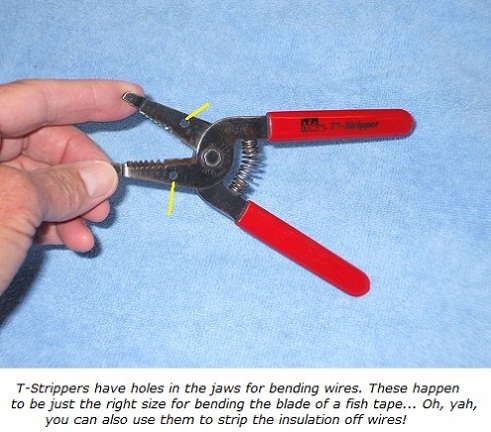
You can also use regular needle-nose pliers to do this, but I’ve
found that I need all my grip strength to do the bending. Pliers require
you to also squeeze the handles together, just to hold the end
of the tape. The T-Stripper eliminates that part, since the tape is held
securely by the hole.
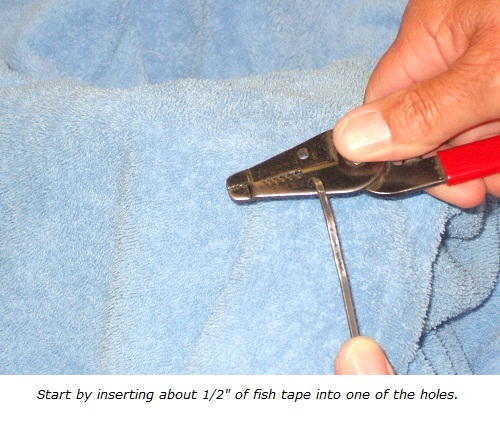
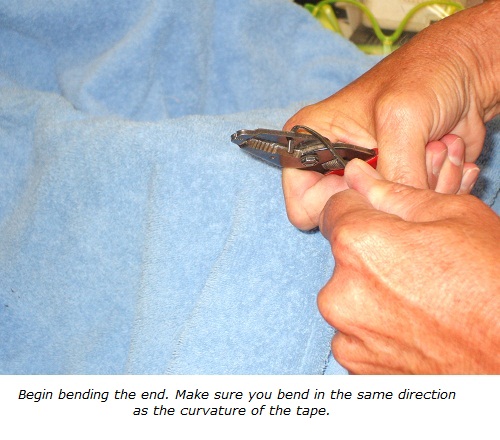
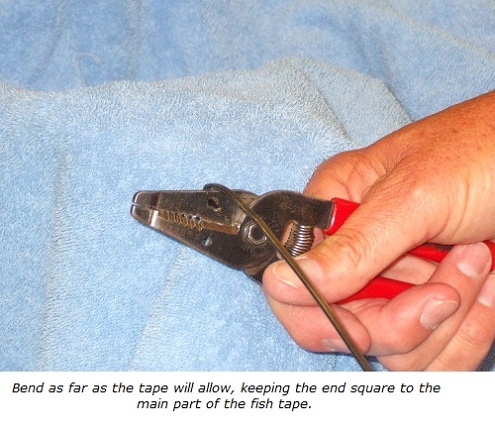
The strippers will only curl the end so far, until they hit the main portion of the tape. At that point, switch to regular slip-joint pliers, or better yet, channel-lock pliers. This will allow you to close the hook up nearly all the way.
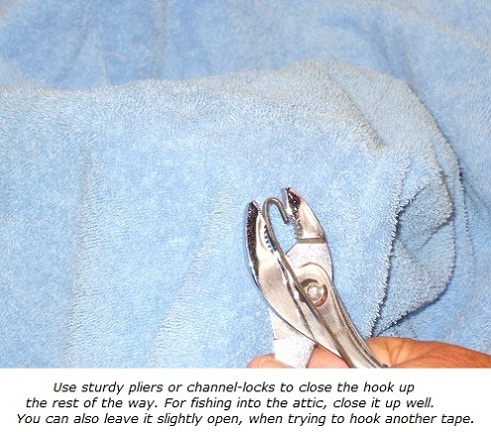
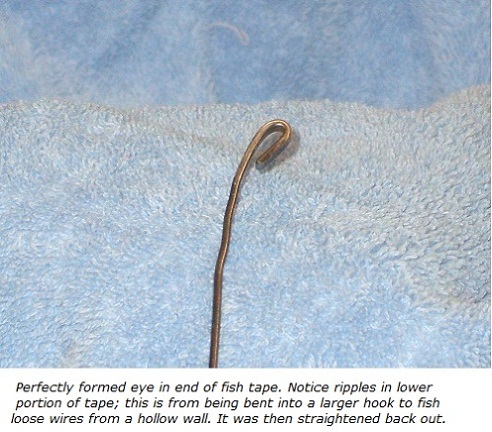
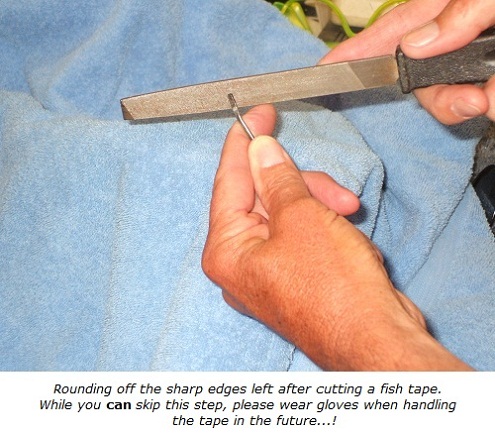
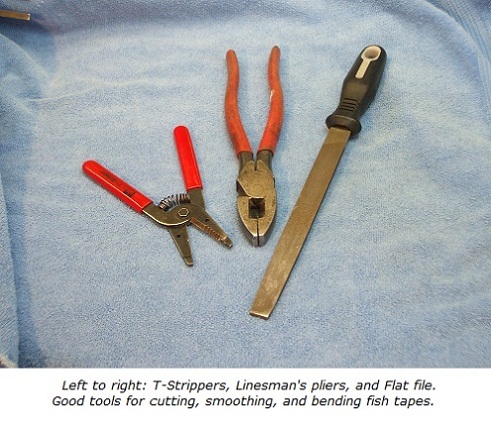
Before bending a new hook, clean up the broken end of the tape. If necessary, cut it off square using bolt cutters or lineman’s pliers. Then, use a flat file or grinding wheel to smooth off the sharp edges.
If you haven't done so already, get a few Free Home Security Systems Quotes from companies in your area.
This will give you a good idea of what it would cost to have a system installed, as well as how much you could save by doing it yourself.
Related Articles
Fishing Wires for a Home Security System
Using a Fish Tape to Install Home Alarm Wiring
Return to Home-Security-Systems-Answers from Choosing Fish Tapes for Home Alarm Wiring
Return to DIY Home Security Systems from Choosing Tapes for Home Alarm Wiring
Note: Feel free to print any of the articles on this site for personal, non-commercial use. Just look for this button:
If you found this website especially helpful, you might want to consider making a small donation. Since 2011, AzAlarmGuy has been providing free help and advice on home security systems to all of those in need.
Your gift, in any amount, will help me keep this website a free resource for anyone needing help with alarm system issues or questions.
Disclosure
I receive affiliate commissions from some of the companies and products I discuss. These commissions don't change the price that you pay.
Rest assured that this compensation does not influence my recommendations. I only endorse products and services that I truly believe to be an honest value for you, as a visitor to my site.
For more details, see my full disclaimer.
